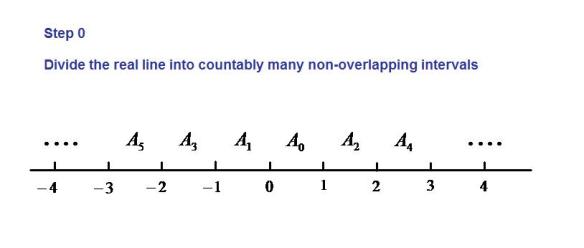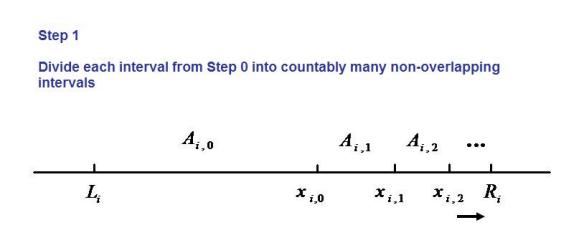Let denote the real number line and
denote the set of all irrational numbers. The irrational numbers and the set
occupy an important place in mathematics. The set
with the Euclidean topology inherited from the full real line is a topological space in its own right. Thus the space
has some of the same properties inherited from the Euclidean real line, e.g., just to name a few, it is hereditarily separable, hereditarily Lindelof, paracompact and metrizable. The space of the irrational numbers
has many properties apart from the full real line (e.g.
is totally disconnected). In this post, we look at a topological description of the space
.
Let be the set of all nonnegative integers. Then the space
of irrational numbers is topologically equivalent (i.e. homeomorphic to) the product space
where each
has the discrete topology. We will also denote the product space
by
. We have the following theorem.
Theorem
The space of irrational numbers is homeomorphic to the product space
.
Because of this theorem, we can look at irrational numbers as sequences of nonnegative integers. Specifically each irrational number can be identified by a unique sequence of nonnegative integers. We can think of each such unique sequence as an address to locate an irrational number. In the remainder of the post, we describe at a high level how to define the unique addresses, which will also give us a homeomorphic map between the space and the product space
.
___________________________________________________________________________
Step 0
Put the rational numbers in a sequence such that
. We divide the real line into countably many non-overlapping intervals. Specifically, let
,
,
, etc (see the following figure).

To facilitate the remaining construction, we denote the left endpoint of the interval by
and denote the right endpoint by
.
Step 1
In each of the interval , we further divide it into non-overlapping intervals. The left endpoint and the right endpoint of the interval
are
and
, respectively. We choose a sequence
of rational numbers converging to the right endpoint
. Then let
,
,
, etc (see the following figure).

Two important points to consider in Step . One is that we make sure the rational number
is chosen as an endpoint of some interval in Step 1. The second is that the length of each
is less than
.
Step 2
In each of the interval , we further divide it into non-overlapping intervals. The left endpoint and the right endpoint of the interval
are
and
, respectively. We choose a sequence
of rational numbers converging to the left endpoint
. Then let
,
,
, etc (see the following figure).

As in the previous step, two important points to consider in Step . One is that we make sure the rational number
is chosen as an endpoint of some interval in Step 2. The second is that the length of each
is less than
.
___________________________________________________________________________
Remark
In the process described above, the endpoints of the intervals are rational numbers and we make sure that all the rational numbers are used as endpoints. We also make sure that the intervals from the successive steps are nested closed intervals with lengths
. The consequence of this point is that the nested decreasing closed intervals will collapse to one single point (since the real line is a complete metric space) and this single point must be an irrational number (since all the rational numbers are used up as endpoints of the nested closed intervals).
In Step where
is an odd integer, we make the endpoints of the new intervals converge to the right. In Step
where
is an even integer, we make the endpoints of the new intervals converge to the left. This manipulation is to ensure that the nested closed intervals will never share the same endpoint from one step all the way to the end of the process.
Thus if we have , then
and in fact has only one point that is an irrational number.
On the other hand, for each point , we can locate inductively a sequence of intervals,
, containing the point
. This sequence of nested closed intervals must collapse to a single point and the single point must be the irrational number
.
The process described above gives us a one-to-one mapping from onto the product space
. This mapping is also continuous in both directions, making it a homeomorphism. the nested intervals defined above form a base for the Euclidean topology on
. These basic open sets have a natural correspondance with basic open sets in the product space
.
For example, for ,
is a local base at the point
. One the other hand, each
has a natural counterpart in a basic open set in the product space, namely the following set:
___________________________________________________________________________
The above process establishes that the countable product of the integers, , is equivalent topologically to the Euclidean space
.
